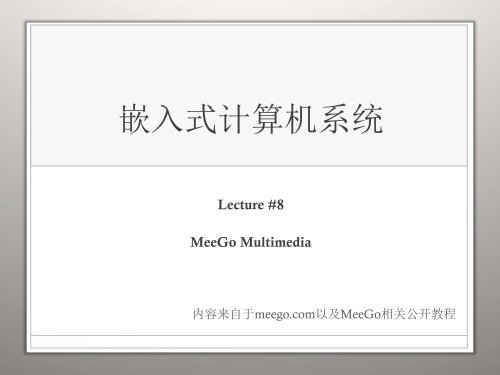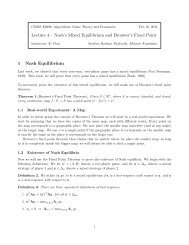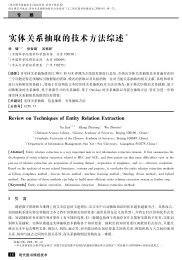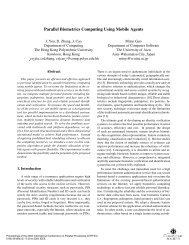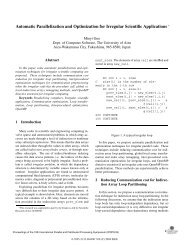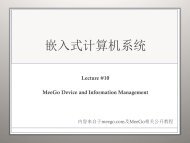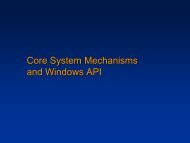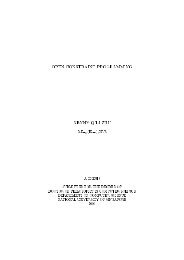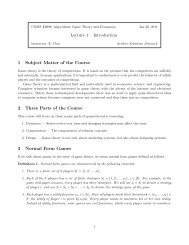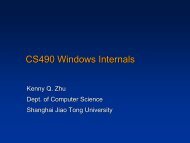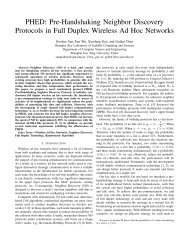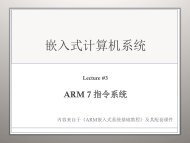嵌入式计算机系统 - Computer Science and Engineering
嵌入式计算机系统 - Computer Science and Engineering
嵌入式计算机系统 - Computer Science and Engineering
Create successful ePaper yourself
Turn your PDF publications into a flip-book with our unique Google optimized e-Paper software.
嵌 入 式 计 算 机 系 统<br />
Lecture #8<br />
MeeGo Multimedia<br />
内 容 来 自 于 meego.com 以 及 MeeGo 相 关 公 开 教 程
Outline<br />
• MeeGo Multimedia Module Overview<br />
• Qt Mobility Multimedia<br />
• GStreamer Framework<br />
• APIs in Qt Mobility Multimedia
Multimedia in MeeGo Architecture
Multimedia in MeeGo Architecture
Media Stack Architecture <br />
Media Application<br />
Core OS<br />
GStreamer<br />
Qt-Mobility<br />
MeeGo Touch<br />
framework<br />
Qt<br />
libva<br />
Other core modules<br />
HW/Driver<br />
Video<br />
Decoder<br />
Video<br />
Encoder<br />
Graphics<br />
SST audio<br />
engine<br />
5
Multimedia in MeeGo Platform API<br />
• GStreamer<br />
• PulseAudio
Multimedia in MeeGo API
Qt Mobility Overview<br />
• Qt Mobility Project provides desirable functions for<br />
mobile platform<br />
• Qt Mobility covers a collection of APIs or frameworks <br />
Bearer<br />
Management<br />
Contacts Location Message Multimedia<br />
Publish <strong>and</strong><br />
subscribe<br />
Qt Service<br />
Framework<br />
Sensors<br />
API<br />
System<br />
Info<br />
…
Qt Mobility Multimedia Module<br />
• QtMobility’s media library will<br />
• Easily create applications with system media capabilities<br />
• Cover the items of most direct interest to developers<br />
• playback<br />
• recording<br />
• playlist<br />
• management<br />
• metadata<br />
• radio<br />
• media editing<br />
• TV<br />
• transcoding<br />
• streaming
Qt Mobility Multimedia Module<br />
• Advantage:<br />
• Implement fundamental Multimedia functions with<br />
minimal code<br />
• A great deal of flexibility with the media source<br />
• Many different codecs are supported 'out of the box'
Qt Mobility Multimedia Module<br />
• High Level APIS<br />
• Encapsulate the ability to manipulate media stream at varying level<br />
without detailed knowledge of media subsystem<br />
QT Mobility Multimedia High Level APIs<br />
Playback List<br />
Recording Playback Radio Camera ..<br />
Audio<br />
Video<br />
QT Mobility Multimedia Service
QtMobility Multimedia Module<br />
• Service - access to low-level of Multimedia function<br />
• QAudio*<br />
• QAudioDeviceInfo, QAudioInput, QAudioOutput<br />
• Low level cross platform audio API<br />
• Low latency notifications, simple game, audio data processing/visualisation.<br />
• QVideo*<br />
• QAbstractVideoBuffer, QVideoFrame, QabstractVideoSurface<br />
• Low level tools for passing video frames.<br />
• Abstraction for video buffers <strong>and</strong> surfaces
QtMobility Multimedia Module<br />
• QT MMF supports rich backend:<br />
• GStreamer<br />
• Quicktime<br />
• Directshow<br />
• …<br />
QT MMF<br />
QuickTimeService<br />
Plugin<br />
QuickTimeService<br />
GStreamer Service<br />
Plugin<br />
QGstreamerService<br />
MyService
What is GStreamer<br />
• A framework for creating media applications<br />
• Pipeline based<br />
• Not a player<br />
• One of the most obvious uses is to build a media player<br />
• Main advantage<br />
• Pluggable elements could be mixed to form arbitrary<br />
pipelines to support various kinds of video/audio codecs<br />
• Unified API for user to create pipelines <strong>and</strong> media players
GStreamer Framework
Concepts in GStreamer<br />
• Element<br />
• Pad<br />
• Bin<br />
• Pipeline<br />
• Communication Mechanism
Concepts in GStreamer-element<br />
• Element<br />
• Element is the most important object in GStreamer, it is derived<br />
from GstObject<br />
• Create a chain of elements linked together <strong>and</strong> let data flow through<br />
this chain of elements
Concepts in GStreamer-element<br />
• The way to create an element<br />
GstElement *element;<br />
element = gst_element_factory_make(“fakesrc”, “source”);<br />
if(!element) {<br />
g_print(“Failed to create element\n”);<br />
return -1;<br />
}
Concepts in GStreamer-element<br />
• Using an element as a GObject<br />
GstElement *element;<br />
gchar *name;<br />
element = gst_element_factory_make(“fakesrc”, “source”);<br />
if(!element) {<br />
g_print(“Failed to create element\n”);<br />
return -1;<br />
}<br />
//get the name of element<br />
g_object_get(G_OBJECT(element), “name”, &name, NULL);<br />
g_print(“The name of element is %s.\n”,name);<br />
g_free(name);
Concepts in GStreamer-element<br />
• Linking elements<br />
GstElement *pipeline;<br />
GstElement *source, *filter, *sink;<br />
pipeline = gst_pipeline_new(“my-pipeline”);<br />
source = gst_element_factory_make(“fakesrc”, “source”);<br />
filter = gst_element_factory_make(“identity”, “filter”);<br />
sink = gst_element_factory_make(“fakesink”, “sink”);<br />
gst_bin_add_many(GST_BIN(pipeline), source, filter, sink, NULL);<br />
if(!gst_element_link_many(source, filter, sink, NULL)) {<br />
g_warning(“Failed to link element!”);<br />
}
Concepts in GStreamer-element<br />
• Element States<br />
• GST_STATE_NULL<br />
• GST_STATE_READY<br />
• GST_STATE_PAUSED<br />
• GST_STATE_PLAYING<br />
• Setting the element state<br />
• gst_element_set_state()<br />
• gst_element_sync_state_with_parent()
Concepts in GStreamer-pad<br />
• Pad<br />
• Pad is used to negotiate links <strong>and</strong> data flow between<br />
elements in GStreamer<br />
• Pad could be sink pad or source pad<br />
• Pad can restrict the type of data that flows through it
Concepts in GStreamer-pad<br />
• Pad<br />
GObject<br />
+----GstObject<br />
+----GstElement<br />
+----ffdemux_ogg<br />
Pad Templates:<br />
SRC template: 'video_%02d'<br />
Availability: Sometimes<br />
Capabilities:<br />
ANY<br />
SRC template: 'audio_%02d'<br />
Availability: Sometimes<br />
Capabilities:<br />
ANY<br />
SINK template: 'sink'<br />
Availability: Always<br />
Capabilities:<br />
application/ogg<br />
GObject<br />
+----GstObject<br />
+----GstElement<br />
+----GstMpeg2dec<br />
Pad Templates:<br />
SRC template: 'src'<br />
Availability: Always<br />
Capabilities:<br />
video/x-raw-yuv<br />
format: { YV12, I420, Y42B }<br />
width: [ 16, 4096 ]<br />
height: [ 16, 4096 ]<br />
framerate: [ 0/1, 2147483647/1 ]<br />
SINK template: 'sink'<br />
Availability: Always<br />
Capabilities:<br />
video/mpeg<br />
mpegversion: [ 1, 2 ]<br />
systemstream: false
Concepts in GStreamer-pad<br />
• An example of using Dynamic pads<br />
static void cb_new_pad(GstElement *element, GstPad *pad, gpointer data) {<br />
gchar *name;<br />
name = gst_pad_get_name(pad);<br />
//setup a new pad link for the newly create pad<br />
…<br />
}<br />
GstElement *demux;<br />
demux = gst_element_factory_make(“oggdemux”, “demuxer”);<br />
//listen for newly create pads<br />
g_signal_connect(demux, “pad-added”, G_CALLBACK(cb_new_pad), NULL);
Concepts in GStreamer-Bin&Pipeline<br />
• Bin & Pipeline<br />
• A Bin is a container for a collection of elements. E.g. playbin<br />
• A pipeline is a special subtype of a bin that allows execution of all of<br />
its contained child elements.<br />
• A pipeline is a top-level bin. As you set it to PAUSED or PLAYING<br />
state, data flow will start <strong>and</strong> media processing will take place.<br />
• GstPipeline is derived from GstBin
Concepts in GStreamer-Bin&Pipeline<br />
• Pipeline example - a simple ogg player
Concepts in GStreamer-Bin&Pipeline<br />
• Creating a bin <strong>and</strong> add elements<br />
GstElement *bin, pipeline, *source, sink;<br />
//create pipeline<br />
pipeline = gst_pipeline_new(“my_pipeline”);<br />
//create bin<br />
bin = gst_bin_new(“my_bin”);<br />
source = gst_element_factory_make(“fakesrc”, “ source”);<br />
sink = gst_element_factory_make(“fakesink”, “sink”);<br />
//add elements to the bin<br />
gst_bin_add_many(GST_BIN(bin), source, sink, NULL);<br />
//add the bin to the pipeline<br />
gst_bin_add(GST_BIN(pipeline), bin);
Concepts in GStreamer-Communications<br />
• Mechanism for communication <strong>and</strong> data exchange<br />
between the application <strong>and</strong> the pipeline<br />
• buffers: sent between elements in the pipeline<br />
• events: sent between elements or from the application to<br />
element<br />
• messages: posted by element <strong>and</strong> collected by<br />
application<br />
• queries: application or element queries information from<br />
other element
Concepts in GStreamer-Communications<br />
• Different communications flows in GStreamer<br />
pipeline
Concepts in GStreamer-Communications<br />
• Example of using bus<br />
static GMainLoop *loop;<br />
static gboolean my_bus_callback(Gbus *bus, GstMessage *message,<br />
gpointer data) {<br />
switch(GST_MESSAGE_TYPE(message)) {<br />
case GST_MESSAGE_ERROR: {<br />
…<br />
break;<br />
}<br />
case GST_MESSAGE_EOS: {<br />
…<br />
break;<br />
}<br />
default:<br />
break;<br />
}<br />
}
Concepts in GStreamer-Communications<br />
• Example of using bus<br />
GstElement *pipeline;<br />
GstBus *bus;<br />
pipeline = gst_pipeline_new(“my_pipeline”);<br />
bus = gst_pipeline_get_bus(GST_PIPELINE(pipeline));<br />
gst_bus_add_watch(bus, my_bus_callback, NULL);<br />
loop = g_main_loop_new(NULL, FALSE);<br />
g_main_loop_run(loop);
Tools in GStreamer<br />
• gst-inspect<br />
• Print info about a GStreamer plugin or element<br />
• Example:<br />
gst-inspect oggdemux<br />
• gst-launch<br />
• Build <strong>and</strong> run a GStreamer pipeline<br />
• Example:<br />
gst-launch filesrc location=/home/child.ogg ! mad !<br />
alsasink
Example of video player<br />
QT MMF API QT MMF Backend GStreamer Base 3 rd party plugins<br />
Player->play()<br />
QServicePlugin<br />
QGstremerService<br />
Playbin2<br />
Typefind/autoplug<br />
Demuxer<br />
Decoder<br />
Developing<br />
Developed<br />
Filter<br />
…
Multimedia Module API Hierarchy<br />
QObject<br />
QMediaObject<br />
QMediaService<br />
QMediaControl<br />
QMediaPlaylist QMediaRecorder QVideoWidget<br />
QAudioCaptureSource<br />
QCameraControl<br />
QCamera<br />
QMediaPlayerControl<br />
QMediaImageViewer<br />
QMediaRecorderControl<br />
QMediaPlayer
Multimedia Module API<br />
• Multimedia module consists of APIs related to<br />
• audio<br />
• video<br />
• image<br />
• camera
Multimedia Module API<br />
• Multimedia module consists of APIs related to<br />
• audio<br />
• video<br />
• image<br />
• camera
Audio<br />
• Classes related to Audio<br />
• QAudioCaptureSource<br />
• QAudioDeviceInfo<br />
• QAudioEncoderControl<br />
• QAudioEncoderSettings<br />
• QAudioEndpointSelector<br />
• QAudioFormat<br />
• QAudioInput<br />
• QAudioOutput
QAudioCaptureSource<br />
• Provides an interface to query <strong>and</strong> select an audio input<br />
endpoint<br />
• Get <strong>and</strong> Set audio input to use
QAudioCaptureSource<br />
• Functions in QAudioCaptureSource<br />
• Qlist QAudioCaptureSource::audioInputs() const<br />
Returns a list of available audio inputs<br />
• void QAudioCaptureSource::setAudioInput(const Qstring &name)<br />
Set the active input to name
QAudioCaptureSource<br />
• Example to use QAudioCaptureSource<br />
QAudioCaptureSource *audiosource = new QAudioCaptureSource;<br />
//get audio input device names<br />
Foreach(const QString &device,audiosource->audioInputs()) {<br />
ui->deviceBox->addItem(device,QVariant(device))<br />
}<br />
//set audio input device name<br />
audiosource.setAudioInput(boxValue(ui->codecBox).toString());<br />
//set the audiosource to the recorder<br />
QMediaRecorder *capture = new QMediaRecorder(audiosource);<br />
capture->record();
QAudioEncoderSettings<br />
• Provides a set of audio encoder settings<br />
int bitRate()<br />
Return the bit rate of the compressed audio stream in bits per second<br />
void setBitRate(int rate)<br />
Set the audio bit rate in bits per second<br />
QString codec()<br />
Return the audio codec<br />
void setCodec(const QString &codec)<br />
Set the audio codec<br />
QtMultimediaKit::EncodingQuality quality()<br />
Returns the audio encoding quality<br />
void setQuality(QtMultimediaKit::EncodingQuality quality)<br />
Set the audio encoding quality
QAudioEncoderSettings<br />
• Example to use QAudioEncoderSettings<br />
QAudioEncoderSettings audioSettings;<br />
audioSettings.setCodec(“audio/mpeg”);<br />
audioSettings.setQuality(QtMultimediaKit::HighQuality);<br />
audioSettings.setChannelCount(2);<br />
aduioSettings.setEncodingMode(QtMultimediaKit::ConstantQualityEncoding);<br />
//set the audio encoder setting when record<br />
QMediaRecorder *capture = new QMediaRecorder(audiosource);<br />
capture.setEncodingSettings(audioSettings);
QMediaRecorder<br />
• Be used for the recording of media content<br />
• Intended to be used with other media object<br />
such as QAudioCaptureSource, QRadioTuner<br />
• State of QMediaRecorder<br />
• QMediaRecorder::StoppedState<br />
• QMediaRecorder:: RecordingState<br />
• QMediaRecorder:: PausedState
QMediaRecorder<br />
• Signals in class QMediaRecorder<br />
• void durationChanged(qint64 duration)<br />
emitted when the duration of the recorded media has<br />
changed<br />
• void stateChanged(QMediaRecorder::State state)<br />
emitted when a media recorder’s state has changed<br />
• void mutedChanged(bool muted)<br />
emitted when the muted state has changed<br />
• void error(QMediaRecorder::Error error)<br />
emitted when an error has occurred
QMediaRecorder<br />
• Functions in class QMediaRecorder<br />
• void record()<br />
start recording<br />
• void stop()<br />
stop recording<br />
• void pause()<br />
pause recording<br />
• bool setOutputLocation(const Qurl &location)<br />
set the destination location of media content<br />
• void setEncodingSettings(const QAudioEncoderSettings &audio)<br />
set the audio <strong>and</strong> video encoder settings
QMediaRecorder<br />
• Example of using QMediaRecorder
Examples<br />
• Audioinput<br />
• audiooutput<br />
11-8-18 47<br />
Embedded <strong>Computer</strong> Systems
Multimedia Module API<br />
• Multimedia module consists of APIs related to<br />
• audio<br />
• video<br />
• image<br />
• camera
Video<br />
• Classes related to video<br />
• QMediaPlayer<br />
• QMediaPlayerList<br />
• QVideoWidget
QMediaPlayer<br />
• Properties in QMediaPlayer<br />
• duration: the duration of the current media<br />
• muted: the muted state of the current media<br />
• playbackRate: the playback rate of the current media<br />
• playlist: the media playlist being used by the player<br />
object<br />
• position: the playback position of the current media<br />
• volume: the current playback volume
QMediaPlayer<br />
• Properties in QMediaPlayer<br />
• media: the active media source being used by the<br />
player object<br />
• state: the media player’s playback state<br />
QMediaPlayer::StoppedState<br />
QMediaPlayer::PlayingState<br />
QMediaPlayer::PausedState
QMediaPlayer<br />
• Functions in QMediaPlayer<br />
• void play()<br />
start or resuming playing the current source<br />
• void pause()<br />
pause playing the current source<br />
• void stop()<br />
stop playing <strong>and</strong> reset the play position to<br />
beginning<br />
the
QMediaPlayer<br />
• Example to use QMediaPlayer<br />
QMediaPlayer *player = new QMediaPlayer;<br />
player->setMedia(QUrl::fromLocalFile(“/home/song.mp3”));<br />
player->setVolume(50);<br />
player->play();
QMediaPlaylist<br />
• Provide a list of media content to play<br />
• Used with other media object like QMediaPlayer or<br />
QMediaImageViewer
QMediaPlaylist<br />
• Functions in QMediaPlaylist<br />
• bool addMedia(const QMediaContent &content)<br />
append the media content to the playlist<br />
• bool insertMedia(int pos, const QMediaContent &content)<br />
insert the media content to the playlist at position pos<br />
• int mediaCount() const<br />
return the number of items in the playlist<br />
• void next()<br />
advanced to the next media content in playlist<br />
• void previous()<br />
return to the previous media content in playlist
QVideoWidget<br />
• Provides a widget which presents video produced by a<br />
media object
QVideoWidget<br />
• Properties in QVideoWidget<br />
• brightness: int<br />
the brightness of displayed video ranging between -100 <strong>and</strong> 100<br />
• contrast: int<br />
the contrast of displayed video ranging between -100 <strong>and</strong> 100<br />
• hue: int<br />
the hue of displayed video ranging between -100 <strong>and</strong> 100<br />
• saturation: int<br />
the saturation of displayed video ranging between -100 <strong>and</strong> 100<br />
• fullScreen:bool<br />
whether video display is confined to a window or is fullScreen
Example<br />
• Example to use QMediaPlayer with QMediaPlaylist <strong>and</strong> QVideoWidget<br />
playlist = new QMediaPlaylist;<br />
playlist->addMedia(Qurl(“http://example.com/movie1.mp4”));<br />
playlist->addMedia(Qurl(“http://example.com/movie2.mp4”));<br />
player = new QMediaPlayer;<br />
player->setPlayList(playlist);<br />
videoWidget = new QVideoWidget;<br />
player->setVideoOutput(videoWidget);<br />
videoWidget->show();<br />
player->play();
Example<br />
• Videowidget<br />
11-8-18 59<br />
Embedded <strong>Computer</strong> Systems
Multimedia Module API<br />
• Multimedia module consists of APIs related to<br />
• audio<br />
• video<br />
• Image<br />
• camera
Image<br />
• Classes related to Image:<br />
• QMediaImageViewer
QMediaImageViewer<br />
• Properties in QMediaImageViewer<br />
• elapsedTime: int<br />
time elapsed since the current image was loaded<br />
• timeout: int<br />
time that an image is displayed for before moving to<br />
the next image<br />
• state: QMediaImageViewer::State<br />
playlist control state of a slide show
QMediaImageViewer<br />
• Example of using QMediaImageViewer with<br />
QVideoWidget<br />
viewer = new QMediaImageViewer;<br />
videoWidget = new QVideoWidget;<br />
viewer->bind(videoWidget);<br />
videoWidget->show();
QMediaImageViewer<br />
• Example of using QMediaImageViewer with QMediaPlaylist<br />
playlist = new QMediaPlaylist;<br />
playlist->setPlaybackMode(QMediaPlaylist::Loop);<br />
playlist->addMedia(image1);<br />
playlist->addMedia(image2);<br />
playlist->addMedia(image3);<br />
view->setPlaylist(playlist);<br />
view->setTimeout(5000);<br />
view->show();
Multimedia Module API<br />
• Multimedia module consists of APIs related to<br />
• audio<br />
• video<br />
• Image<br />
• camera
Camera<br />
• Provides a framework to use Camera device<br />
features when supported by the platform<br />
• Take still photo<br />
• Take video<br />
• Basic settings including flash mode, zoom level etc<br />
• Classes related to Camera<br />
• QCamera<br />
• QCameraViewfinder<br />
• QCameraImageCapture
Camera<br />
• using camera to capture an image<br />
QCamera *camera = new QCamera;<br />
QCameraViewfinder *viewFinder = new QCameraViewfinder();<br />
viewFinder->show();<br />
camera->setViewfinder(viewFinder);<br />
QCameraImageCapture *imageCapture = new<br />
QCameraImageCapture(camera);<br />
camera->setCaptureMode(QCamera::CaptureStillImage);<br />
camera->searchAndLock;<br />
imageCapture->capture();<br />
camera->unlock();
Camera<br />
• using camera to record video<br />
QCamera *camera = new QCamera;<br />
QMediaRecorder *mediaRecorder = new<br />
QMediaRecorder(camera);<br />
camera->setCaptureMode(QCamera::CaptureVideo);<br />
camera->start();<br />
mediaRecorder->record();


